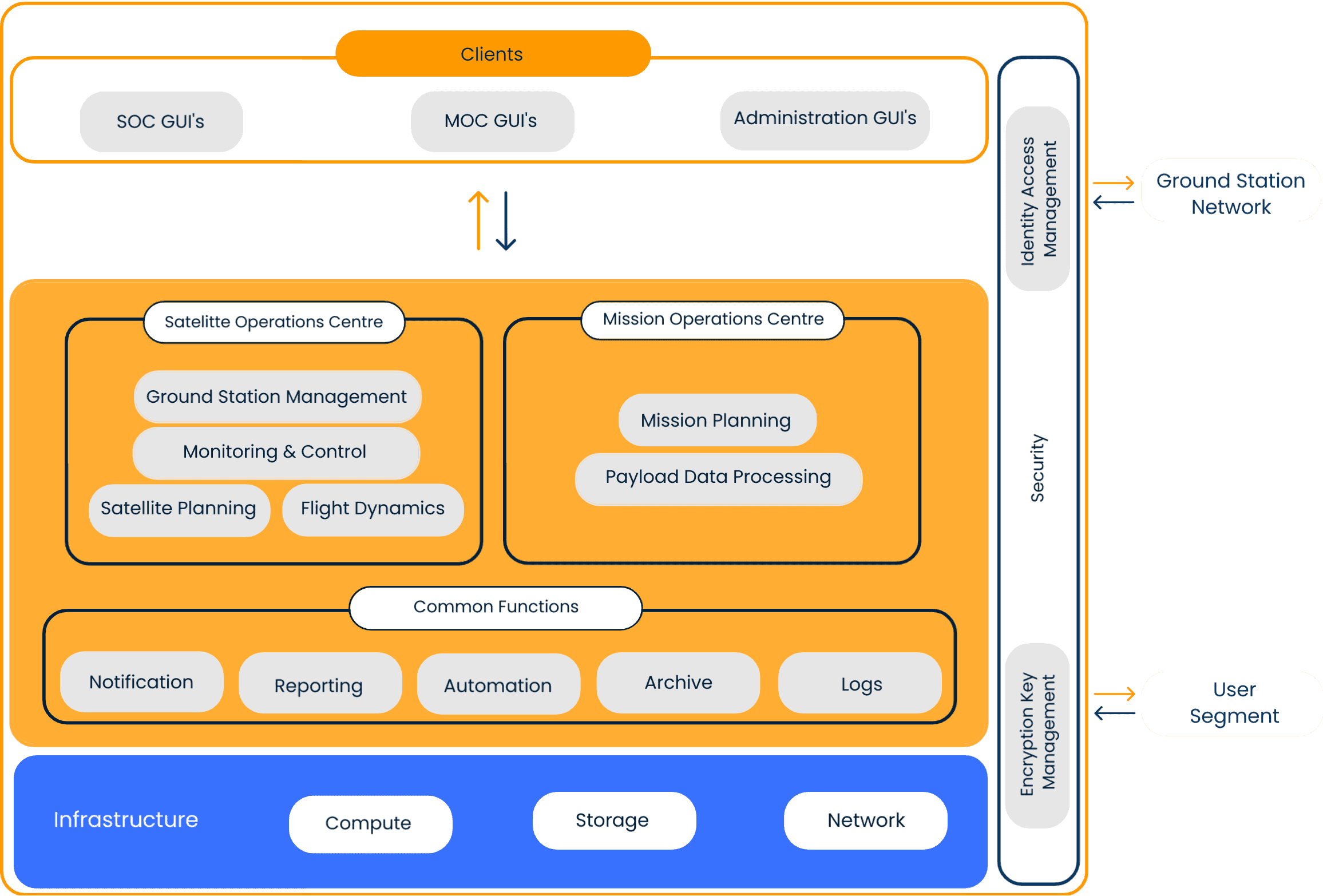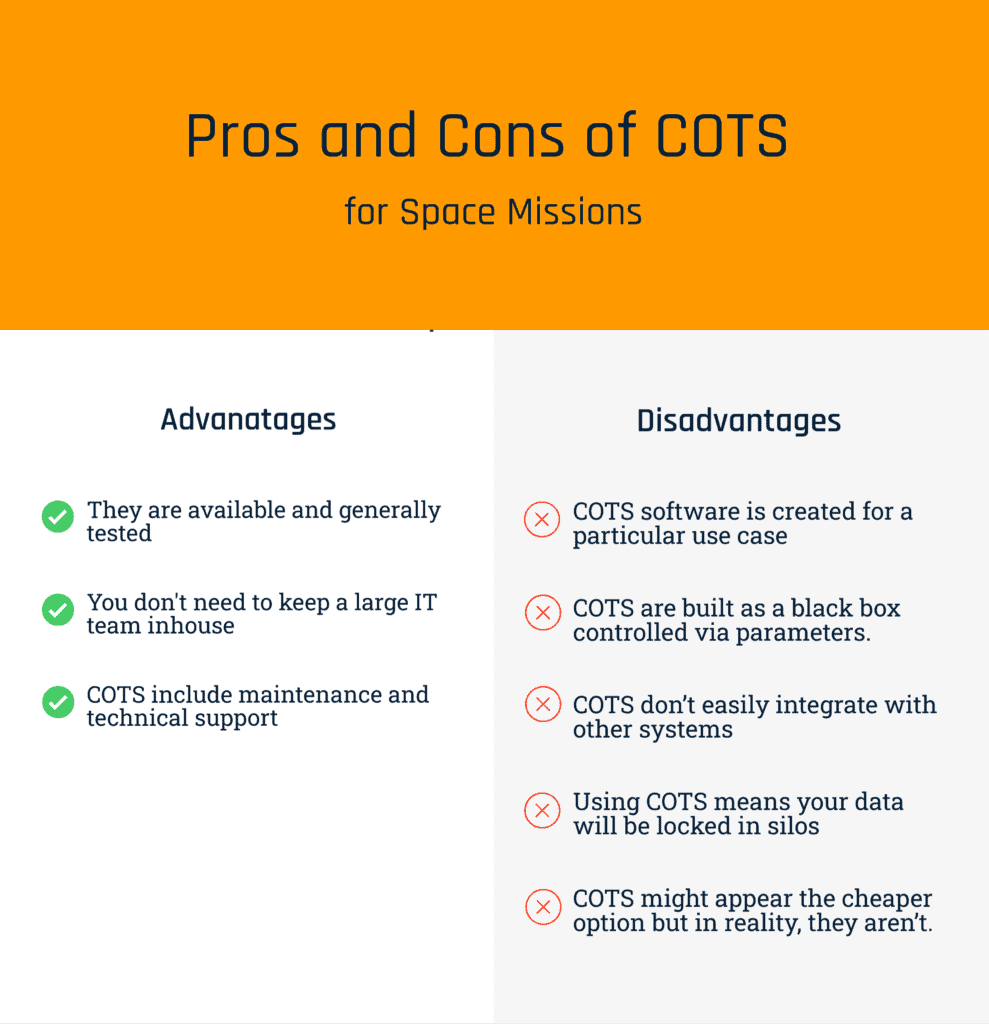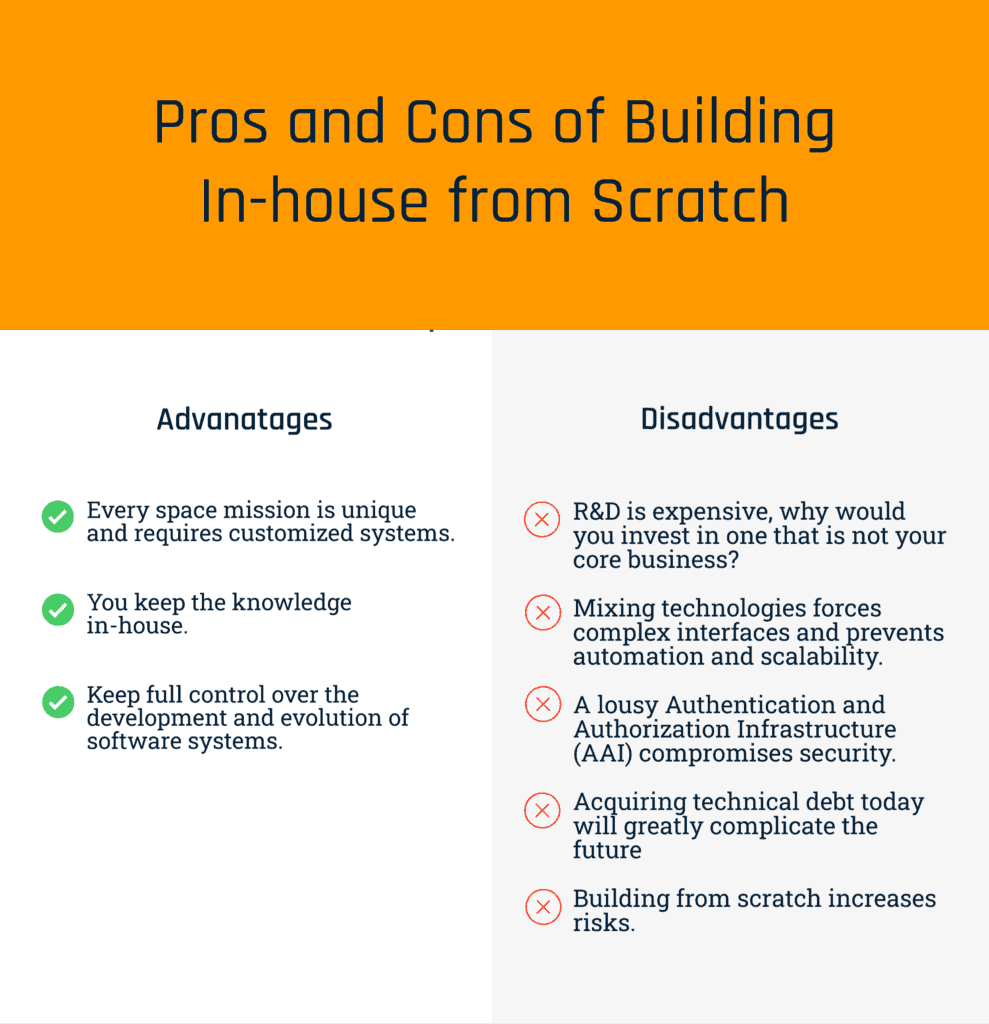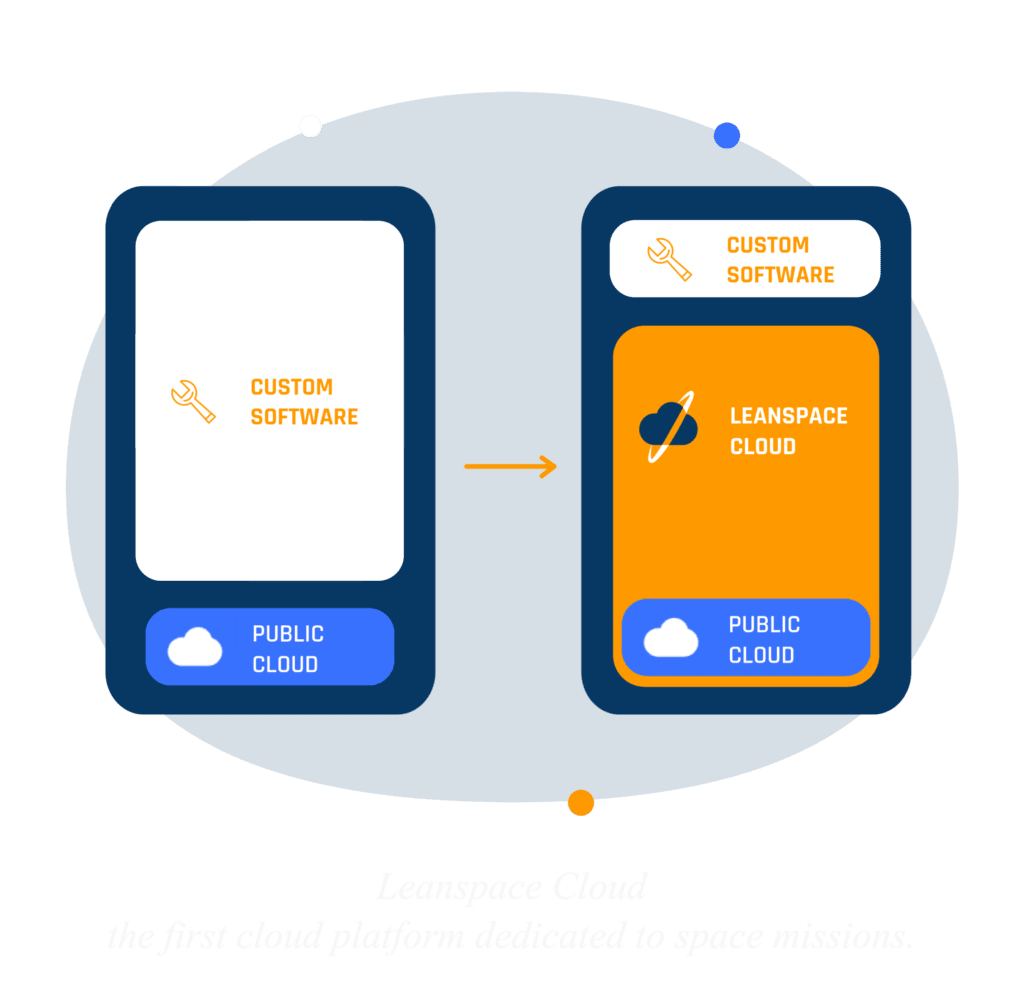A wide variety of software systems are required to operate a space mission. Whether it’s an individual satellite, or a mega-constellation, or a launcher, you will need to monitor & control the assets, plan their activities and manage the ground network, among other things.
A ground segment reference architecture is shown below. Depending on the mission requirements, these systems will be more or less complex, but almost all will be required in one way or another to run successful operations.

What Options Are Available Today To Build Ground Software?
Today, space engineers only have two options to build their ground software: they can develop everything from scratch, or try to customize a commercially-off-the-shelf (COTS) product to the needs of their space mission. Both approaches have advantages and disadvantages, which we will discuss in the following sections.
In response to the shortcomings of these two existing options, an alternative approach has emerged, which combines the advantages of COTS and developing the software systems in-house. Follow the blog until the end to find out more.
Commercially-Off-The-Shelf Products (COTS)
Increased emphasis on lowering costs and shortening delivery times has led companies to develop products that can be reused across customers. Examples are tools for Mission Control, Flight Dynamics or Mission Planning. Using off-the-shelf products to operate a space mission has several advantages:
- They are available and generally tested. COTS typically offer a faster setup than other alternatives, as they are readily available, and reduce risks as they are generally tested by a number of space organizations.
- You don’t need to keep a large IT team inhouse. COTS provide numerous functionalities out-of-the-box, which means you don’t need to keep large IT and software development teams inhouse.
- COTS include maintenance and technical support. If you want to outsource non-core functions, it’s convenient to have a supplier take care of your software systems for you.
The Problem with “One-Size-Fits-All”
Despite the advantages, using off-the-shelf products for the ground segment has numerous shortcomings:
- COTS software is created for a particular use case. The fact is that every space mission is unique, and his one-size-fits-all does not work. You will ultimately need to develop in-house so many things around the COTS that most of its benefits are virtually gone.
- COTS are built as a black box controlled via parameters. You can’t tailor them for example to add functionalities, change the user interface or apart their logic.
- COTS don’t easily integrate with other systems. Even if they claim they do, their architecture is not conceived to interoperate with tools built in-house, other COTS, or service providers such as SSA or ground station networks. It will be up to you to develop and maintain these complex interfaces.
- Using COTS means your data will be locked in silos. Without a central database, your teams will be working with different data sets, leading to inefficiencies. Additionally, user management across systems can become complex and introduce security risks.
- COTS might appear the cheaper option but in reality, they aren’t. You will be paying for a number of included features that you don’t need, and will have to develop yourself many additional ones that you need and are missing.

Build In-house From Scratch
Traditionally, the ground control segment has always been built from scratch, and still today it’s the approach taken by the vast majority of space organizations. This means that every system is re-invented and developed bottom-up, by combining a collection of open-source libraries, commercial tools, and extensive bespoke developments. There is little carry-over or application of lessons learned from previous systems.
Building in-house from scratch has several advantages:
- Every space mission is unique and requires highly customized systems. Developing your tailored software systems, whether done in-house or by a systems integrator, means you can have the tools you actually need, and to your exact use case.
- You keep full control over the development and evolution of your software systems. Vendor lock-in is a big issue when you need to move fast and keep flexibility, and relying on COTS suppliers to make modifications is expensive and time-consuming.
- You keep the knowledge in-house. Your software tools will define how optimally you run operations, so being able to understand them and evolve their capabilities is paramount to improve your efficiency.
The Problem with reinventing the wheel
Building software from scratch was a viable option when space missions were mostly institutional, costed hundreds of millions and took over a decade to accomplish. In today’s commercially-driven environment efficiency is a must, and space organizations need to drastically lower costs, lower risks and fast-track their time to market.
The reasons to avoid building from scratch are typically neglected and their consequences underplayed, but they reveal why this strategy is no longer viable:
- R&D is expensive, why would you invest in one that is not your core business? Building your ground infrastructure from scratch requires in-depth space and software expertise. Backend & frontend developers, system admins, DevOps, ground software engineers… to design, build and maintain all the systems and their interfaces. Most likely this is not the best use of your resources.
- Mixing technologies forces complex interfaces and prevents automation and scalability. Building from scratch means you will need to stitch together disparate systems and technologies that don’t talk to each other and to integrate them you will need to build and maintain complex interfaces. This makes automation a challenge and doesn’t scale as the company grows, forcing you to keep on doing many manual tasks.
- Building from scratch increases risks. Developing new software and interfacing non-compatible tools introduces another risk to your already risky space business. A non-proven infrastructure will require thorough testing, and even then issues will eventually surface.
- A lousy Authentication and Authorization Infrastructure (AAI) compromises security. Building an AAI across multiple systems is a very complex endeavor that requires specific expertise. Your security chain is as strong as its weakest link, so if only one of your tools doesn’t integrate security properly you are giving open access to your data, jeopardizing your entire ground segment.
- Acquiring technical debt today will greatly complicate the future. In-house development teams often end up taking technical shortcuts to expedite the delivery of functionalities required today, triggering a snowball effect that creates a mess down the road.

Despite the drawbacks, building from scratch is the preferred approach by most space organizations, and here are two main reasons for it:
- Each space mission is unique and therefore requires bespoke software tools. There is no way around it, even when using a COTS there is still a big amount of tailored software that needs to be developed around it to make it fit with the mission, so it becomes easier to just build all from scratch.
- Ground software is what drives the value of space missions. Software runs the show, and that is why organizations need to keep control of it; to change it, improve it, and evolve it as their requirements grow.
What if you could build your bespoke software, evolve it as you please, but not need to develop everything from scratch?
What if you could have all the advantages of building software in-house, but with none of the disadvantages?
Build In-House With Leanspace
Both current alternatives to build ground software, using COTS and developing from scratch, provide a suboptimal way to build future-proof systems. This is the reason Leanspace was born.
80% of all ground segment functions are always the same for every single space mission, whether they are a satellite constellation, a launcher or an interplanetary rover. We’re talking about software to decode telemetry packets, send commands or plan ground station passes, to name a few examples. It’s only the 20% on top which is unique for each use case, i.e. the specific protocol, bespoke user interfaces, automation of activities, etc.
Leanspace provides you with this generic 80% in the form of cloud services, easy to use and integrate. See them as building blocks to set up the foundation of your software systems. Developers can pick and choose the ones they need, and build with them entirely custom products by only developing the 20% on top – focused to answer their own use case. Together, these cloud services form the Leanspace Cloud, and ensure standardization, stability, and scalability of your entire software ecosystem.

Building ground software using Leanspace’s cloud services has numerous advantages:
- The most powerful and easy-to-use APIs – All Leanspace services are built API-first, which makes them very easy to use as a backend to fuel your applications, and enables seamless integration with your custom code or any third-party tools. This removes the need to stitch together disparate systems or spend months integrating functionalities.
- Eliminate the risks of developing from scratch – Software built on Leanspace leverages validated products used by many other organizations across the space industry, therefore drastically reducing risks all across the software infrastructure.
- Build your systems as a Single Source of Truth – Leanspace’s services are natively connected, use a harmonized technology and act as a single source of truth. This means that applications you build on top will be fully integrated and use a centralized data model out-of-the-box.
- Run highly automated operations – Having a fully integrated infrastructure means you can finally automate workflows across different systems. Even more, you can actually implement and validate an end-to-end automation in an incremental way, and therefore can trust.
- Build true cloud-native and scalable systems – Now you can easily make use of the power of cloud infrastructures in your ground segment. Leanspace’s cloud services scale automatically and seamlessly on demand, so the software tools you built on top will simply grow with you as you move from 1 satellite to 100.
- Build your systems step-by-step – You can start small and develop just what you need now, by using only a few of our cloud services to develop an MVP (Minimum Viable Product) of your ground segment. As you grow, you can add new functionalities by using more cloud services. Building step by step with Leanspace de-risks your development and enables you to stay flexible to future changing needs.
- Enterprise-grade security at your disposal – Leanspace provides the most advanced enterprise-grade security features, including dedicated clusters, Regional data residency, Encryption at Rest and in transit, Powerful and granular policy-based authorization, Openidconnect based Authentication provider, DDOS protection, Network level security with firewalls and constant security monitoring.
- Only pay for what you use, when you use it – All of the Leanspace services are used and priced independently, following a usage-based model monthly subscription model. This means that starting with little needs equals little cost, and the price only scales as you grow your needs.
- Centralize your user management – Manage user authentication and authorization across your entire software infrastructure from a single place. No more multiple logins, user verifications and granting permissions needed for different systems.
- Lower your supplier dependency – Leanspace offers generic products that you use to build your applications, just like with IT clouds such as AWS or Azure. This means you have full control over your systems, and can maintain and evolve them as required without depending on any suppliers.
The Bottom Line
As space missions become more efficient, fast-paced and cost-effective, the traditional approach to building ground software has become completely outdated. Today, every industry runs on software, and countless organizations in many other verticals leverage cloud platforms like Leanspace to become more competitive.
Leanspace provides a scalable, secure, and cost-effective way to build modern applications to manage space missions. Ground software built on Leanspace benefits from the best of both worlds – it’s reliable and fast to implement like a COTS, and it’s tailored to your needs and allows you to keep control like building from scratch.
So how will you build your ground segment, will you develop from scratch or use a COTS? Or will you choose the best of both worlds and build on Leanspace?
Request your demo today!


